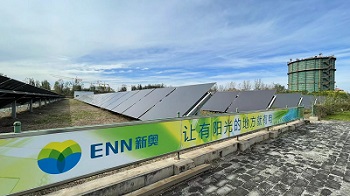Our experience as a leading clean energy and low-carbon solutions provider in China shows it’s a marathon worth running

ENN Energy positions itself as a clean energy service provider that offers low-carbon solutions for industrial, commercial and residential customers in China, a country undergoing rapid energy transition from a carbon-heavy energy structure.
Currently, we offer integrated energy solutions to help customers replace high-emissions fuels with low-carbon natural gas as well as renewable energy, thereby assisting customers in reducing emissions while enhancing their competitiveness along the country’s decarbonization journey.
Further, we are mindful of our own impact on the environment and society during operations. A 10-year decarbonization roadmap has been crafted and a target of net-zero emissions by 2050 has been set, demonstrating our ambition to play a leading role in the country’s decarbonization process.
 In 2021, we helped our customers reduce their carbon footprint by 49 mn tons. Carbon intensity of our operations for the year was 8,060 tce./bil m3, representing a reduction of 17.3 percent compared with the baseline year 2019, even as we expanded the scale of our business.
In 2021, we helped our customers reduce their carbon footprint by 49 mn tons. Carbon intensity of our operations for the year was 8,060 tce./bil m3, representing a reduction of 17.3 percent compared with the baseline year 2019, even as we expanded the scale of our business.
Last October, ENN Energy’s ESG rating was upgraded to ‘A’ by MSCI, the highest ESG rating obtained in Asian gas utility companies. Recognition of our efforts sends a clear signal that we’re on the right track. As we aim for a higher MSCI ESG rating over the next few years, our journey offers an instructive example for other large corporates operating in mainland China.
How we started our journey
Looking back to 2016, driven in part by the Stock Exchange of Hong Kong’s (HKEx) decision to revise rules around ESG reporting following a consultation process, companies listed on the bourse were mandated to publish an ESG report. As is now well known, disclosures were recommended to ‘comply or explain’.
Meanwhile, US-domiciled shareholders reached out and enquired about our ‘CCC’ MSCI ESG rating, which admittedly resulted from a lack of engagement with the ESG rating agency, insufficient ESG data disclosure and inadequate awareness. With shareholders facing the prospect of divesting positions in companies with poor ESG ratings, we began our journey in earnest.
To get to this stage, our IR & sustainability team continually worked with senior management as well as business units and functional departments to ensure ESG was integrated into the company’s business strategy and daily operations, and relevant ESG data was properly disclosed.
It has been our experience that while there are many different agencies providing ESG assessment, each with their own metrics, methodology and scoring mechanisms, it would be best to integrate the ones most relevant to one’s business and which are sought after by investors – for example, MSCI, S&P Global’s CSA, CDP and Sustainalytics.
Company-wide multi-stakeholder efforts on all possible fronts
I believe most IROs will readily agree with me that raising awareness of ESG internally is the biggest challenge.
Not only does senior management need to be convinced of the importance of achieving a high level of performance and collecting data that goes beyond financial and operational matters, but employees at all levels within the company also need to have such awareness to facilitate the implementation of best ESG practices in daily operations.
This is no small task in a large corporation with hundreds of project companies operating in China. To achieve this, we adopted a top-down approach.
By incorporating investor feedback on the company’s ESG performance, the latest update on global ESG development and ESG disclosure requirements in our bi-weekly IR reports, we progressively brought this topic to management’s attention.
A gap analysis benchmarking us against international peers in terms of ESG performance was also conducted, which identified the areas that needed further improvement to catch up with international standards, as well as to secure better ESG scores.
Most importantly, we advised the board to form an ESG committee to steer the formulation of sustainability strategy and set up an ESG working group to co-ordinate and execute relevant strategy.
A link between key ESG performance indicators with the remuneration of senior management and key managers was also established; these are evaluated annually on the achievement of designated ESG matrices.
We also introduced clawback mechanisms to ensure a high and consistent level of ESG performance over a period of time, particularly in the areas of safety operation and environmental impact.
Next, we worked on educating other employees. We launched a series of educational programs, including short video clips that were disseminated across the intranet (viewers were given quizzes on the content and those who obtained high scores were announced on internal platforms). We organized themed workshops at headquarters and webinars for employees all over the country to strengthen their knowledge.
To further build their awareness on ESG matters, we even shared news regarding our improving ESG ratings and awards received via internal platforms and on social media to create resonance with all employees.
Our efforts came to fruition as we now have well-versed internal teams that co-ordinate regular ESG data collection, implement ESG enhancement tasks and contribute innovative ideas in areas like biodiversity protection, methane emission control, gender equality and so on, to drive the sustainable development of the company.
 The next step – integration in development strategy
The next step – integration in development strategy
Last year was marked by extreme weather events. Intense heatwaves, storms and wildfires swept across the globe, while there were horrific floods in China’s Henan province. There are far too many regular reminders of the impact of climate change.
As a leading energy solutions provider, we have started to progressively incorporate the TCFD framework into our ESG reporting to address climate change issues. We also responded to CDP’s climate change questionnaire last year, receiving a debut rating of ‘B’. In the future, we will strive to expand the scope of ESG rating and data providers that we will respond to.
Now that everyone in the company realizes the objectives for such disclosure – that it is not only to cater to investor demand – we are more keenly motivated to integrate a diversified set of ESG standards and frameworks into the company’s overall development strategy, which pushes the boundary on ESG best practices.
In October 2021, we published the first phase of our decarbonization roadmap, Decarbonization Action 2030, clearly laying out the measures we intend to take as a company to decarbonize and promote low-carbon transition among customers and society by the end of the decade. While the efforts are ongoing, I’m pleased to see more integration between ESG and business development. For example, we have deployed advanced technology to measure and manage methane emissions during daily operations, while urging peers in the industry to step up efforts in methane control.
A lot of plans have been put in place pursuing clear objectives but we know more needs to be done.
Our two cents to IROs
As of January 2022, more than 40 percent of our shareholders are signatories to the UN Principles for Responsible Investment, a proportion that we anticipate will grow.
It’s clear IR teams have a role to play to ensure ESG objectives are smoothly integrated into company operations and corporate strategy, and can help bridge the gap between their firm and the best practices stipulated by various ESG rating systems. ESG rating agencies have rightly attracted criticism of late that they only measure the potential impact of the world on the company and its shareholders instead of the company’s impact on the environment and society.
But our experience also shows that such approaches can be an important and proven approach that can help move companies in the right direction, making a tangible impact on both the environment and society.
Edited by Suhas Bhat, copywriter at Hill+Knowlton Strategies (Hong Kong)
This content is provided by ENN Energy Holdings and did not involve IR Magazine journalists. For further information on ENN Energy Holdings please click here.











